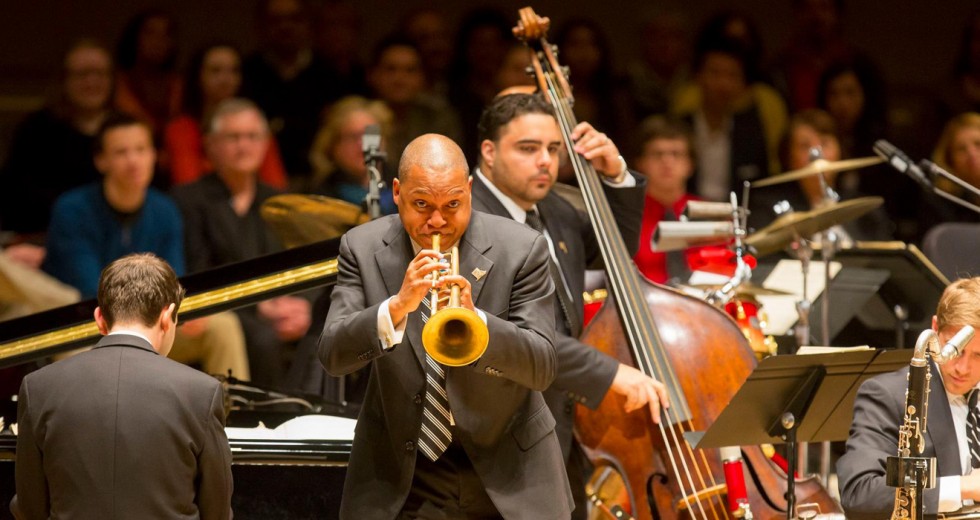
The Chicago Symphony Orchestra’s Symphony Center Presents Jazz Series, under the leadership of James M. Fahey, SCP director of programming, expands the reach of citizen musicianship beyond the CSO’s classical-music audience by bringing diverse communities to Symphony Center. The series also has inspired work with local Chicago Public School students, both in partnership with the Jazz at Lincoln Center Orchestra and other visiting Symphony Center Presents jazz artists, such as a recent collaboration with pianist Jason Moran.
We look forward to what the future of the SCP Jazz Series will bring. To learn more about next season’s Jazz Series — which will feature artists such as Herbie Hancock and Chick Corea, Ahmad Jamal and Dianne Reeves — please visit cso.org.
For nearly 125 years, the CSO has provided Chicagoans with an opportunity to enjoy classical music through excellent performances in Chicago. Symphony Center is also home to other musical genres, which are showcased through Symphony Center Presents, a series that focuses on bringing new genres and artists to the stage at Orchestra Hall. When SCP was first proposed, the goal was to bring a broader and more diverse audience to Orchestra Hall, and to celebrate the work of artists performing genres of music other than classical. While the success of Symphony Center Presents can be attributed to the diverse musical appetite of Chicago audiences, the series has thrived as a result of tireless work by Jim Fahey, SCP’s director of programming. His ability to cultivate relationships with a wide variety of artists and managers has contributed significantly to the cultural diversity onstage at Orchestra Hall.
Recently, the SCP Jazz Series celebrated its 20th anniversary in an event featuring the Jazz at Lincoln Center Orchestra, as well as a public celebration of Fahey’s work as the series’ program director, and his 30 years of work with the CSO. With the final SCP Jazz concert of this season approaching on June 12, we spoke with Fahey about his work with Symphony Center Presents and the inspiration behind its Jazz Series.
What inspired the SCP Jazz Series?
In the 1993/1994 season, when I took over Symphony Center Presents, [jazz-pop vocalist] Mel Tormé was set to perform, so I thought, “We could do a jazz series.” We started in 1994 and launched it with four concerts. The following year, we had five concerts, and since then it’s continued to flourish and grow in size.
Did you see the series as a way to bring in more people to Symphony Center?
I think there was a lengthy history of people in certain communities of Chicago not feeling welcome here at the hall, and I think the jazz series was certainly a way of addressing that first, all audiences – all Chicagoans – should feel welcome here and second, this music deserved to be able to take the same stage as the Chicago Symphony, these artists in a great art form.
So we brought in artists to play jazz, and be featured in their own series. But we also brought in jazz artists to perform with the Orchestra. So Marcus Roberts, Branford Marsalis, and other incredible jazz musicians are playing classical music on stage with the CSO. There’s a whole list of artists that have appeared with the orchestra on subscription concerts.
The Jazz at Lincoln Center Orchestra has been involved in the jazz series almost as long as it’s been running. To what do you attribute its success?
I think that we’ve been able to establish an experience with JALCO. As opposed to them coming in for the night for a single concert, we wanted to figure out a way to bring them in to do more. At first, this was done by adding educational activities both here at Symphony Center and in schools in Chicago. We also added a Jazz for Young People concert for youth and family audiences, which the JALCO performs three to four times annually in New York.
Could you elaborate on these educational activities?
At first, the activities involved lecture-demonstrations by Wynton Marsalis, hosted here at Symphony Center for specific school groups. There were also school visits, where individual members of JALCO would visit schools to work with their jazz programs. It’s evolved to include a master clinic and school visits. Instead of individual members from JALCO, two or three musicians now visit the schools.
What do you want to see for the future of the series?
One of the things that I’ve tried to do over the years with the series is introduce new artists as an integral part of the series — to say that this art form is in the future, and not related to the past. I’d like to continue bringing in new artists, to celebrate their art and also to expose their music to our audiences.
I’d also like to continue commissioning, either with a local or national artist. Last year for our Rivers Festival, we worked with Woodward Davis. This year, we commissioned pianist Jason Moran to write a piece for our Truth to Power Festival. Next year, we’re commissioning Dana Hall.
I’m also hoping that we’ll continue to partner with different arts institutions. We bring JazzLinks students from the Jazz Institute of Chicago to our concerts, and they come to almost all of them. It would be great to see that continue and grow.

